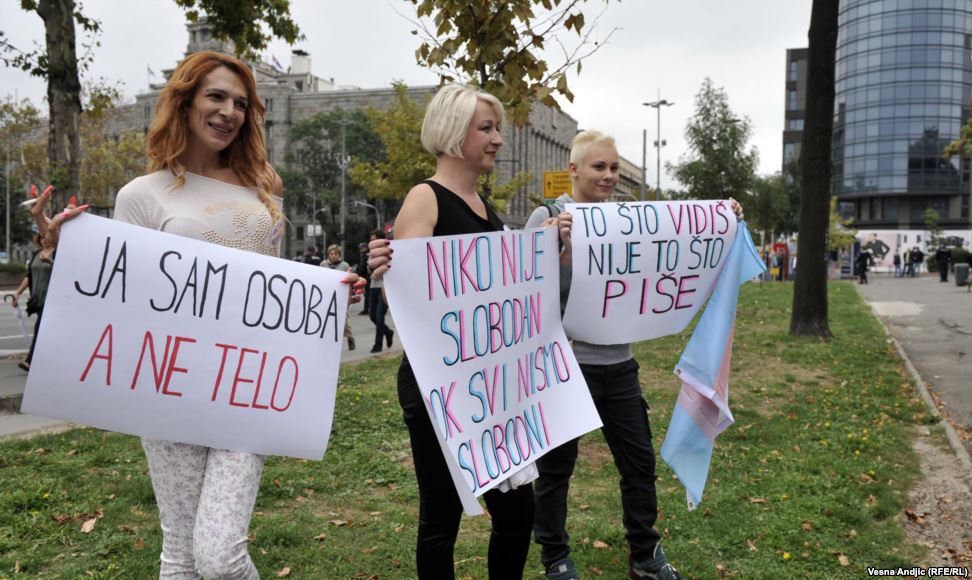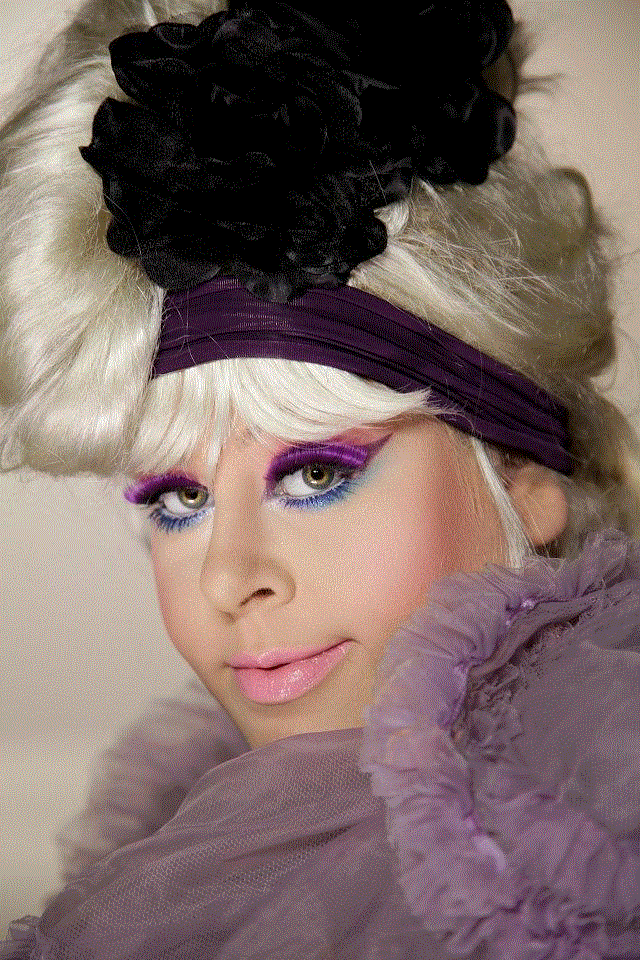
4 Photos
The latest installment in our Queer as Turbofolk series looks at gender and performance.When upcoming Bosnian-Serb starlet Slađana Guduraš disappeared in December 2014 after setting off to drive from her boutique in Bijeljina to her apartment in Belgrade, both local media and her new partner Zoran Makivić, who’d reported her missing, initially assumed she’d been kidnapped by her abusive ex-boyfriend – who, according to press reports, she’d split up with just a month earlier after walking in on him kissing hairstylist and singer Aleksandar Kapriš, a member of Dejan Milićević’s production team. These fears were well-founded: Slađa’s ex had threatened her that she would “end up like Ksenija Pajčin”, and a week before her disappearance, he reportedly attacked her at the Sarajevo hotel she’d been staying in with fellow singer Miki Mećava after their joint talk-show appearance. Mećava later told the press that Slađa spoke of her fear of being murdered, and had been unwilling to join the rest of the group at a restaurant due to safety fears, preferring to stay in her hotel room. Six days after her disappearance, Slađa’s crashed car was found in a canal in Sremska Mitrovica with her body inside, having apparently swerved off the road.
In the above video for her only single, 2013’s Silikoni i kubici, Slađa’s self-aware sense of humor is evident – the knowingly trashy spot approaches its subject matter with a refreshing sense of irony and social commentary almost never seen in genre videos, both celebrating and parodying the turbofolk lifestyle and aesthetic, even subtly condemning it. The lyrics and visuals toy with ideas of hyper-gender, comparing the silicone breast implants favored by young women trying to make it in the industry with the protein powder, creatine and steroids used by men to enhance their own physical assets. Beneath the gaudy hedonism, as rapper Juice points at Slađa’s twerking bottom and exclaims “Yeah bitch, now shake that ass!”, the video unusually captures a disquieting sense of bleakness and nihilism that recalls Uros Čvoro’s description of “thundering exalted melancholy” as the core emotional affect of turbofolk. Like many of her colleagues, the heavily cosmetically enhanced Slađa invested in her body to improve her economic circumstances (as the song’s title suggests, she even sings of how many cubic centimeters of silicone her breasts and lips contain), but Silikoni i kubici’s final line rapped by Juice in English – “Make money for me, make money for me… yeah, you know who’s the pimp” – reminds us that this is on male terms, and that women in the post-Yugoslav estrada industry can sometimes remain vulnerable and exploited despite their empowered and amazonesque presentation.
Another moment in the song when Slađa sardonically refers to servicing a queue of men strengthens this impression, serving to ironically critique the starleta industry and illustrating what Ivana Kronja describes as “the clear prostitution and commodification of women as a basic characteristic of the Warrior Chic style” in her 2004 paper Turbo Folk and Dance Music in 1990s Serbia: Media, Ideology and the Production of Spectacle. In the context of 1990s Serbia, Kronja lays the blame for this on “poverty, war, criminal expansion, the strengthening of persistent patriarchy, and also by the direct influence of western mass culture products where the woman is presented as a sex object.” Kronja writes that “[the] prostitution of women is sometimes indirect or hidden, known as the phenomenon of ‘sponsored girls,’ while modeling can easily be the screen behind which procuring is hidden. The position of women within this subculture is precisely described in the lyrics of [Bumbar by Lina] […] one of the rare songs that openly criticize the sexual order in [1990s] turbo-folk subculture.”
“I went out that evening, I was alone and looking for my friends in a disco club,” sings Lina over a jaunty rhythm that recalls early Ace Of Base. “Somewhere out of the darkness, he approached me, with a tie around his neck, fat as an elephant. He told me he would like to take me across the pond. But first, in the booth, when we sat down, he asked me what I would like to drink – I realized it was gonna turn bad. When his hand started touching my waist, I understood it all and I was sick.” Kronja notes that “a young man of model looks with long hair appears half-naked in the video”, commenting on the clip’s gay aesthetic and reporting that “gay men are also present at the [1990s] turbo-folk subcultural scene in some numbers […] usually working in Serbian fashion and show-business, while some of them only ‘hang around,’ wishing to attract some wealthy and powerful sponsors by their beauty.”
Slađa’s story is an eerie echo of Michel Faber’s 2000 novel Under The Skin (loosely adapted into a 2013 film by Jonathan Glazer), in which to escape a life of poverty and drudgery, a young woman living in a society of huge economic inequality agrees to undergo massive cosmetic surgery – most notably, the addition of a comically large pair of artificial breasts that she cannot feel – to act as a lure for men, only to experience exploitation and assault before dying in a car crash. But it’s also too reminiscent of the road deaths of singers Silvana Armenulić, Mirjana Bajraktarević, Toše Proeski, Louis (Ljubiša Stojanović) and Darko Radovanović, three of which occurred in the past decade. Perhaps the main takeaway from Slađa’s untimely exit is that much of former Yugoslavia needs safer fucking roads – statistics show that Serbia has 4 times as many road fatalities per 100,000 motor vehicles as Western European countries like Germany and the UK, and even 3 times as many as Slovenia. Given how EU investment has transformed the quality of many roads in newly acceded states like Poland, this might just the best argument for Serbia’s membership.
In her 2014 paper Feminine Libidinal Entrepreneurship: Towards a reparative reading of the sponzoruša in turbo folk, Dijana Jelača discusses in detail the “hyper-feminine drag” and “techno-gender” commonly exhibited by women in genre videos and exemplified by Guduraš’s aesthetic, characterizing the sponzoruša (sponsored girl) “as a figure that deploys her very features of sexual difference towards an enactment of class mobility during precarious times”, thereby embodying “a potentially transgressive challenge to traditional gender roles” within the performative domain of “technologically mediated, post-socialist femininity”. Jelača argues that “[contrary] to the dominant critical dismissal of the phenomenon as inherently anti-feminist, the sponzoruša figure has the potential to reveal deeply contradictory tendencies of popular culture: to both reaffirm and transgress some of society’s most troubling hierarchies. […] This challenge [to gender roles], embodied in what I call a cyborg-goddess, exposes both femininity and class identity as historically and economically contingent factors of women’s material and cultural marginalization. [The sponzoruša in turbofolk] has the potential – though not a guarantee – to short-circuit a clean boundary between nature and technology and the ways in which this binary constitutes womanhood as such.” Jelača sees the sponzoruša as a figure who “confronts precarity by appropriating femininity into a libidinal enterprise, and into a performance of techno-gender: an enactment of aggressive, castrating hybrid-femininity that is quite overtly […] inorganically manufactured and materially driven. […] turbo folk’s aesthetics fuse with the figure of the sponzoruša to make gender into an overtly ‘put on,’ staged, and technologized, deeply unnatural process.”
Jelena Karleuša is the archetypal example of this “cyborg-goddess” – as Marina Blagojević writes in “Invisible Body and Powerful Disembodiment: Serbian Media in the 1990s” (“Nevidljivo telo i močna bestelesnost: Mediji u Srbiji u 90-im”), the popular singer “is not natural nor is that her goal”. Jelača goes beyond this, describing Karleuša’s versions of womanhood as “transgressive performances that masquerade identity so much so that ‘natural’ becomes disposed of altogether in favor of cyborg-entities posing as ‘women,’ while winking at the audience in a knowing exchange by which identity in general, and gender in particular, are exposed as inherently inauthentic to begin with. Moreover, the utilization of threatening, ‘manipulative’ sexuality, by which this manufactured cyborg-goddess achieves her goals, could be read as an undoing of patriarchal power which positions women only as objects of male pleasure, never as subjects of pleasure in their own right.”
“The body of the female folk singers resembles drag queen shows, and that feature is being recognized in the public discourse, since one might often hear in Serbian tabloid press and everyday speech that these female singers look like transvestites,” reports Olga Dimitrijević in her 2008 M.A. thesis The body of the female folk singer: constructions of national identities in Serbia after 2000. Dimitrijević describes Jelena Karleuša as “the most prominent example” and one even happy to toy with this notion. “In the video spot for the song ‘Slatka mala’ […] shots of Jelena Karleuša are juxtaposed with images of three drag queens who [impersonate her]. Karleuša plays with associations of her body with [a] transvestite body […].” One recalls how early in her career, Lady Gaga – on record as having copied much of Karleuša’s aesthetic – was similarly accused of secretly being a man on account of her unorthodox aesthetic. Jelača understands the questioning of womanhood as a “disciplining device […] referring to [Karleuša] as a ‘tranny’ [reasserts] gender-normative and homophobic premises upon which ‘femininity-proper’ and ‘culture-proper’ are preconditioned.”
The above stage performance of Slatka mala from Karleuša’s 2010 concert DVD, shot in the packed Beogradska Arena, is the most explicitly and revolutionarily pro-gay moment in turbofolk history. In a film on the arena’s video wall, Karleuša mouths the words “love and marriage” while removing a rainbow flag from a washing machine and hanging it up to dry, intercut with shots of naked male dolls in various scenarios and soundtracked to an audio collage of gay-themed quotes from U.S. pop culture, including The Simpsons and 1981 Bill Murray vehicle Stripes. This segues into a sequence where Karleuša repeats the word “liberta” over techno synths while coquetting with balloons in the colors of the rainbow. As her cries of “liberta” crescendo to a scream, a troop of male dancers dressed in sailor suits marches onto the stage waving rainbow flags to a military drumbeat, before Jelena emerges atop a giant pink cake being pushed by yet more sailors and chaperoned by four muscly orange go-go boys dressed only in hotpants and angel wings. It’s not most people’s image of Serbia, to put it mildly – and I love how the washing-machine sequence also allows Jelena to subvert patriarchal expectations of a woman’s role.
Karleuša is a big inspiration for amateur drag performer Amanda Dior, a member of Germany’s post-Yugoslav diaspora who regularly posts videos of herself meeting her favorite ex-Yugoslav stars at concerts in her local area, as well as homemade productions like this drag performance of JK’s 2012 hit Nova Religija (Plava Šeherezada), a cover of Bollywood song Dum Dum Mast Hai.
Another queer performer inspired by Serbian pop-folk and Jelena Karleuša in particular is San Diego’s Leonard McNair, whose now-closed Youtube channel of turbofolk covers was featured on TV and in magazines in Serbia and Bosnia in 2009. Over a period of a few years, Leo regularly posted clips of himself dancing and lip-syncing to hits by JK, Dunja Ilić, Goga Sekulić and even C-lister Sexy Sandra among others, leading to inevitable headlines like “Crnac gej najveći fan Jelene Karleuše?!” (“Is Jelena Karleuša’s biggest fan a black gay guy?!”). If turbofolk means this much to a young gay man on the other side of the planet with no cultural or familial link to Serbia, there’s obviously a real phenomenon at play here. As Olga Dimitrijević writes, “The awareness of performance creates the clear link between female folk stars and gay audiences, moreover, many female neofolk stars have been constructed as gay icons. As Richard Dyer claims using the example of Judy Garland, gay icons and their construction, lead ‘to a discussion of the culture produced by gay men, thus telling us not about how gay men have been represented by the dominant media, but how gay men have used an image in the dominant media as a means of speaking to each other about themselves’. The whole process is being enforced through the audience’s awareness of [the] invisible production team that stands behind the female folkstars, with the inexplicable feeling that, as Alexander Doty puts it, ‘some homosexual must have something [to do] with this’.” In other words, gay people feel spoken to by the music and imagery, and sense the involvement of kindred spirits, even if they don’t understand a word being sung. A few of Leonard’s videos are still available to watch, like his no-budget re-enactment of the clip for Jelena Karleuša’s “Testament”.
Female singer Danijela Petković has employed a drag queen aesthetic in her music videos (directed by Dejan Milićević) to the extent that I initially thought she was one – an impression shared by the Serbian yellow press, who made much of her resemblance to drag act Boki 13 in the clip for her single Dom Perinjon.
The latest breakthrough for turbofolk on the gender front came earlier this year, when controversial singer and reality TV star Nataša Maza came out as a transwoman and marched at Belgrade Pride. Her latest video Dekolte (which means what you think it does) even brings trans-on-cis lesbian snogging to the game, which is probably why it has so many Youtube likes despite being ramshackle and shockingly out of tune.
Maza’s heavily surgically accentuated body and face recall those of her cisgender colleagues. Her back catalogue is a little better than Dekolte would suggest – and she’s also notable for composing most of her songs herself, including Opasan, Trevapice, Čaše, Kopija, Malo sreće and ballad Zamišljam. Her rendition of folk song Padajte kiše, composed by regular collaborator Milan D. Šoškić, is a traditional treat.
Get more Queer as Turbofolk here:
Queer as Turbofolk (Part I): “Eastern Europe is Homophobic”
Queer as Turbofolk (Part II): Body Politics
Queer as Turbofolk (Part III): Academic Voices





